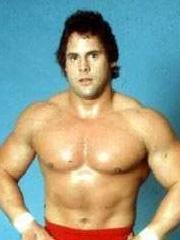| Rick McGraw | |
|---|---|
 | |
| Birth name | Richard McGraw |
| Born | (1955-03-19)March 19, 1955 Charlotte, North Carolina, U.S. |
| Died | November 1, 1985(1985-11-01) (aged 30) Fair Haven East, Connecticut, U.S. |
| Cause of death | Heart attack |
| Spouse(s) | Lisa |
| Professional wrestling career | |
| Ring name(s) | Rick McGraw |
| Billed height | 5 ft 7 in (1.70 m) |
| Billed weight | 235 lb (107 kg) |
| Billed from | Charlotte, North Carolina |
| Trained by | Rip Hawk |
| Debut | 1975 |
Richard McGraw (March 19, 1955 – November 1, 1985) was an American professional wrestler, best known for his appearances with the World Wrestling Federation (WWF) under the ring name "Quickdraw" Rick McGraw from 1980 until his death in 1985. Rick was a wrestler at Elon College 1973–74.
Professional wrestling career
McGraw began his career in 1975 in the Florida area. He adopted the nickname "Quickdraw" in reference to the cartoon character Quick Draw McGraw. He competed in the Mid-Atlantic region a couple of years later before entering the World Wrestling Federation. McGraw defeated enhancement talent, but mostly put over heels who were ready to challenge WWF champion Bob Backlund. He also competed on the Showdown at Shea show in August 1980, losing to Greg Gagne.
McGraw left the WWF and competed for various regional territories of the National Wrestling Alliance. He was one-half of The New York Dolls with The Dream Machine (managed by Jimmy Hart) in the World Wrestling Association, winning the WWA World Tag Team Championship in 1982. Rick then re-entered Vince McMahon Sr.'s WWF as part of the tag team called The Carolina Connection with Steve Travis. Quickdraw had notable matches with numerous top heels during his time in the WWF. He was once managed by Arnold Skaaland and also had his neck "broken" by Killer Khan in a match. Towards the end of his career, McGraw teamed up with André the Giant to form a lopsided tag team duo: McGraw was 5'7" with the Giant billed at 7'4".
On the October 26, 1985, episode of WWF Championship Wrestling, McGraw was a guest on Roddy Piper's "Piper's Pit" segment and got on the host's case about always shooting his mouth off and not wrestling on television, prompting Piper to accept a challenge to wrestle him on the show the next week. During his entrance, Piper repeated "I'm going to show you why they don't let me wrestle on TV." McGraw wore Piper's signature "Hot Rod" T-shirt to the ring before blowing his nose on it and throwing it at Piper to start the match. Piper quickly took control, throwing McGraw out of the ring and twice into the guardrail. After no-selling several punches and kicks in McGraw's comeback, Piper hit him with a swinging neckbreaker and two DDTs, the second prompting the referee to stop the match, declaring McGraw unable to continue. Piper stomped him a few times then yelled into a camera, "That's why they don't let me wrestle on TV!" Coincidentally, the unusually violent match (taped October 22) aired the morning after McGraw died, leading some viewers to assume Piper killed him. Off TV, McGraw had at least three matches in the interim, with The Spoiler, Randy Savage and Mike Sharpe.
Personal life
McGraw was married to Lisa. The couple had a single child, Ricky.
Death
McGraw died of a heart attack on November 1, 1985. Shortly after, Roddy Piper headlined a show held to benefit McGraw's family. Fellow professional wrestler Bret Hart noted in his autobiography that McGraw regularly consumed Placidyl and suggested this resulted in his heart failing.
Championships and accomplishments
- Continental Championship Wrestling
- Lutte Internationale
- Pro Wrestling Illustrated
- Ranked #485 of the top 500 singles wrestlers of the "PWI Years" in 2003
- World Wrestling Association
See also
References
- ^ Irv Muchnick (2007). Wrestling Babylon: Piledriving Tales of Drugs, Sex, Death, and Scandal. ECW Press. p. 143. ISBN 978-1-55490-286-6.
- ^ Shields, Brian; Sullivan, Kevin (2009). WWE Encyclopedia. Dorling Kindersley. p. 239. ISBN 978-0-7566-4190-0.
- Cawthon, Graham (2013). the History of Professional Wrestling Vol 3:Jim Crockett and the NWA World Title 1983-1989. CreateSpace Independent Publishing Platform. ISBN 978-1494803476.
- ^ Cawthon, Graham (2013). the History of Professional Wrestling Vol 1: WWF 1963 - 1989. CreateSpace Independent Publishing Platform. ISBN 978-1492825975.
- Oliver, Greg (April 1, 2005). The Pro Wrestling Hall of Fame: The Tag Teams. ECW Press. ISBN 978-1-77090-557-3.
- ^ Mike Rickard (December 1, 2008). Wrestling's Greatest Moments. ECW Press. p. 79. ISBN 978-1-55490-331-3.
- "Did Roddy Piper Kill Rick McGraw in the Ring?", by Mike Rickard
- Rick McGraw match listing, from WrestlingData.com
- Solomon, Brian (April 1, 2015). Pro Wrestling FAQ: All That's Left to Know About the World's Most Entertaining Spectacle. Hal Leonard Corporation. ISBN 978-1-61713-627-6.
- Rowdy Roddy Piper; Robert Picarello (November 5, 2002). In the Pit With Piper: Roddy Gets Rowdy. Penguin Publishing Group. p. 138. ISBN 978-1-4406-7329-0.
- Bret Hart (September 15, 2009). Hitman: My Real Life in the Cartoon World of Wrestling. Ebury Publishing. ISBN 978-1-4070-2931-3.
- Royal Duncan & Gary Will (2006). "Alabama: NWA Alabama Heavyweight Title". Wrestling Title Histories (4th ed.). Archeus Communications. ISBN 0-9698161-5-4.
- Harris M. Lentz III (January 1, 2003). Biographical Dictionary of Professional Wrestling, 2d ed. McFarland. p. 51. ISBN 978-0-7864-1754-4.
- "Wrestling Information Archive - Pro Wrestling Illustrated's Top 500 Wrestlers of the PWI Years". June 16, 2008. Archived from the original on June 16, 2008. Retrieved September 26, 2017.
- "W.W.A. World Tag Team Title (Indianapolis)". Puroresu Dojo. 2003. Archived from the original on April 26, 2003.
External links
- Rick McGraw at IMDb
- Rick McGraw's profile at Cagematch.net
 , Internet Wrestling Database
, Internet Wrestling Database 